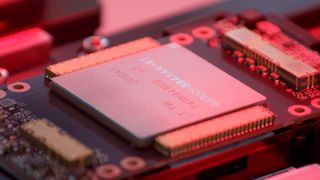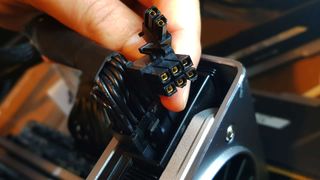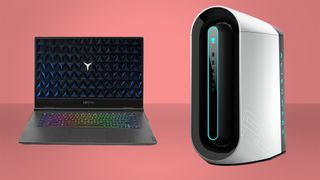Nvidia's rumored new Ampere power connection could drive gamers towards Big Navi
If I'm going to have to buy a whole new PSU to run my RTX 3080 Ti Founders Edition, then I might wait for AMD's RDNA 2.

The new Nvidia Ampere graphics cards might need a whole new PSU, pushing PC gamers towards AMD's Big Navi cards instead... if reports of a new 12-pin PCIe power connector are to be 100 percent believed. As always the GPU rumor field is intensifying as we circle ever closer around the eventual GeForce launch day, and this latest suggests Nvidia's next-gen Founders Edition cards will sport a new power connector to deliver around 400W of power to the top-end Ampere GPUs.
Though this 12-pin connector could, in theory at least, be able to deliver anything up to 600W. If it were running in optimal conditions with higher-spec pins, apparently. Given that other performance rumors have posited expected Nvidia Ampere TDPs to be around the 350W mark it does kinda make sense for some new super-powered connector to be utilized.
The report stems from a Chinese outlet, FCPowerUp (via Overclockers), which claims to have received confirmation that Nvidia will be using a new 12-pin connector on its upcoming RTX 30-series graphics cards. According to the report the new plug is similar in scale to the current Molex Micro-Fit connector used on current-gen GPUs, and should take up the same amount of space as one of the 6+2 pin connectors high-end cards use.
There is also a potential 4-pin connector, though the FCPowerUp writer doesn't have any idea what it could be for, or even whether it's actually a power interface at all.
They claim, if I'm reading the machine translation correctly, that the new 12-pin interface may only be used on the reference cards being shipped out by Nvidia itself and that the actual add-in board (AIB) partners, such as Asus, Gigabyte, and MSI, may just stick to the current standard Molex Micro-Fit cabling.
But this is all kinds of troubling, and I am having real difficulty trying to figure out how much Creedence I give this report. Is this rumor a Fortunate Son or a Side o' the Road? There are sensible reasons for Nvidia potentially wanting to introduce a new power socket: given the new Ampere GPUs might exceed the 350W power draw suggested by the TDP ratings, when it comes to total board power, they may well need all of the potential 400W the new cables can offer.
Then there is the sometimes dodgy cabling you can get from some existing power supplies. We experienced a few issues using certain single PSU cables which split out into twin 6+2 pin connectors when we first checked out the RTX 2080 all those years ago. So Nvidia using a single, more robust cable for its flagship (and likely overclocked) Founders Edition card has some validity.
The biggest gaming news, reviews and hardware deals
Keep up to date with the most important stories and the best deals, as picked by the PC Gamer team.

Though I'm not aware of any PSUs currently available that utilize the new 12-pin connector, which would necessitate either PSU manufacturers offering compatible replacement cables before the Nvidia Ampere cards are released, or else releasing a new wave of supplies timed with the GeForce launch. That or Nvidia bundles an adapter in the box, though that pretty much negates the utility of a new, stable power connector.
For Nvidia to potentially rely on PC gamers picking up a new high-end PSU at the same time as a new high-end Founders Edition graphics card strikes me as an odd choice. And would surely push more people towards the impending AMD Big Navi RDNA 2 cards, which are expected to launch only a little later on.
To be fair there is a new PSU standard (.pdf warning) on the way, introduced by Intel, and potentially also set to arrive this year. The ATX12VO (12V only) is expected to appear first with system builders, but will eventually hit the DIY market too. But that needs whole new motherboard designs to deal with the 10-pin board connection, and honestly I'm not expecting that to happen until there's another new CPU generation, HEDT or not.

Best gaming PC: the top pre-built machines from the pros
Best gaming laptop: perfect notebooks for mobile gaming
My only other thought about this potential new graphics card power connection is that it's something which might appear on the Founders Edition circuit board, but won't actually have any relevance to the end user. When the potential designs for the new Ampere cards leaked out there was talk of the Nvidia-specific GeForce PCB being relatively short, meaning there needed to be some cabling hidden under the shroud, between the power connectors on the end of the card and the circuit board itself.
There is the possibility that Nvidia is using this new 12-pin connection internally to offer a robust interface capable of pulling the necessary power from a standard twin 6+2 pin connection across one internal cable. It would add expense to the overall design, but that doesn't seem to be a concern in the world of the Founders Edition. That would also explain why the AIB designs don't utilize the same plug socket.
But, as ever, it's all rumor and speculation right now until we see those new Nvidia Ampere graphics cards in the flesh. There's a good chance this whole rumored 12-pin connection won't see the LED of day on consumer cards at all. Though given the increased cadence of rumors and leaks, I don't think we're going to have that long to wait to find out.

Dave has been gaming since the days of Zaxxon and Lady Bug on the Colecovision, and code books for the Commodore Vic 20 (Death Race 2000!). He built his first gaming PC at the tender age of 16, and finally finished bug-fixing the Cyrix-based system around a year later. When he dropped it out of the window. He first started writing for Official PlayStation Magazine and Xbox World many decades ago, then moved onto PC Format full-time, then PC Gamer, TechRadar, and T3 among others. Now he's back, writing about the nightmarish graphics card market, CPUs with more cores than sense, gaming laptops hotter than the sun, and SSDs more capacious than a Cybertruck.
Most Popular






